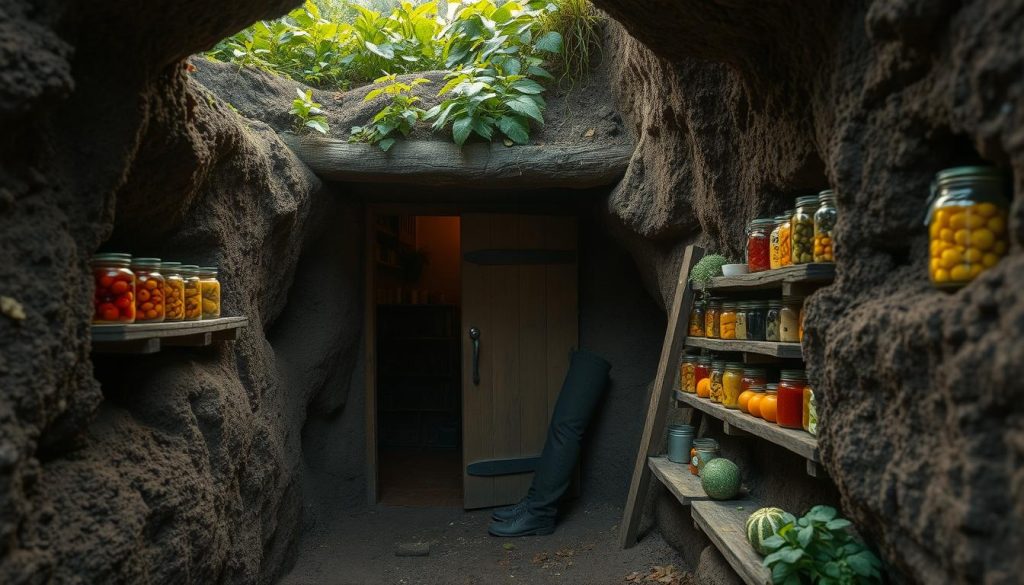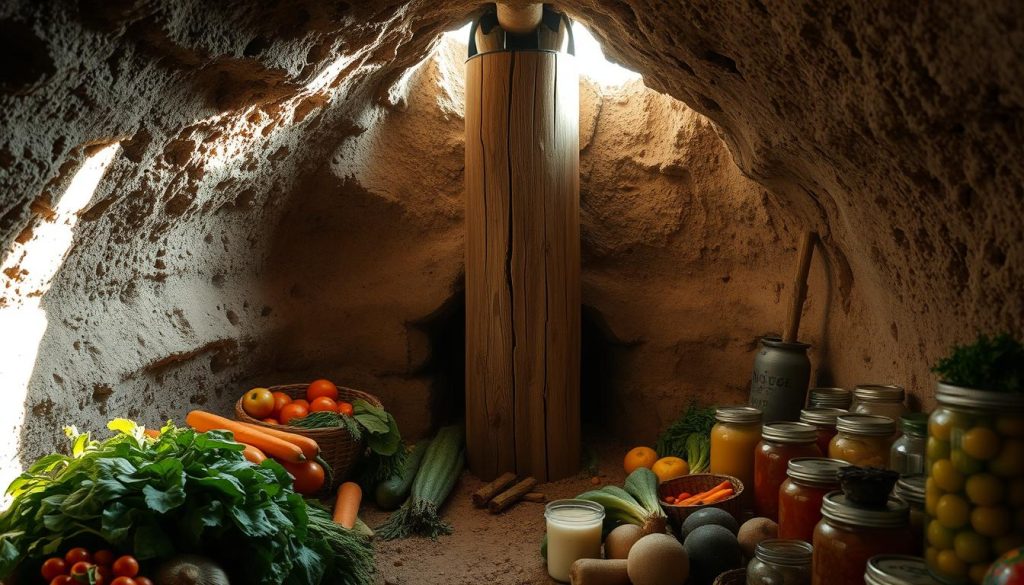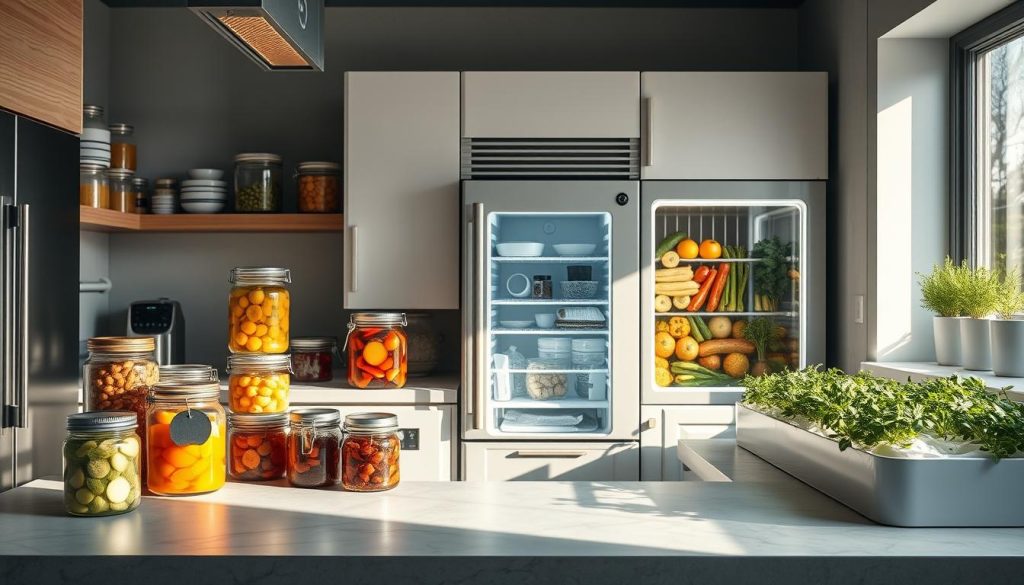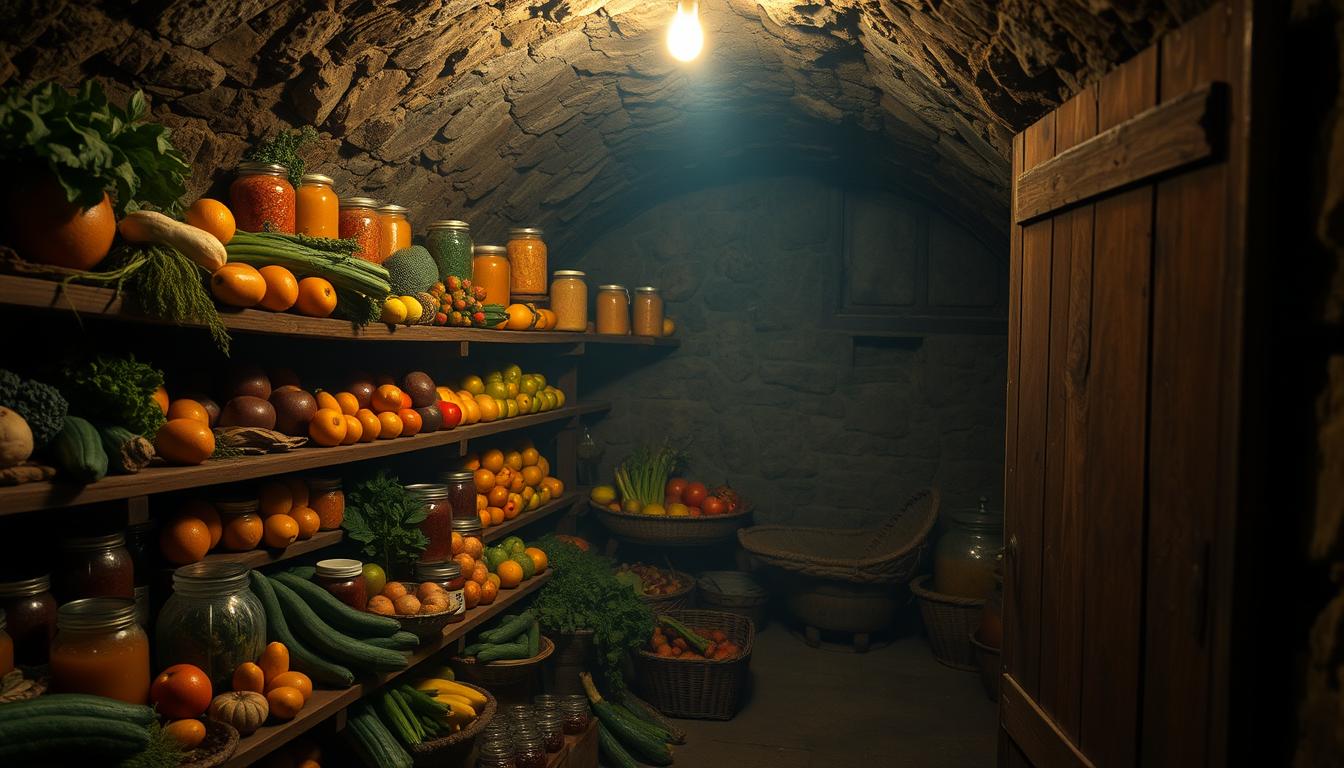Welcome to our guide on root cellars! These underground storage spaces have been around for centuries. They use the earth’s cooling to keep food fresh. Root cellars keep produce fresh without electricity, making them great for food sustainability.
What Is a Root Cellar?
Root cellars are fascinating parts of our history. They were key for storing food before modern refrigeration. These cellars use the earth’s natural conditions to keep food fresh.
They are made for storing fruits, vegetables, and other perishables. This way, they keep food fresh using natural cooling methods.
Definition and Purpose
A root cellar is an underground or partially underground space. Its main job is to keep food cool and stable. It also controls humidity levels.
By using natural cooling, a root cellar acts as an eco-friendly cooler. It helps keep food fresh for longer. These cellars stay cool all year, making food storage easy without electricity.
History of Root Cellars
Root cellars have a long history that spans centuries and cultures. They were first used for historical food preservation needs. People worldwide have used them to store their harvests safely.
From ancient China’s ice houses to European settlers in North America, the idea has evolved. It shows how people have always found ways to preserve food naturally. This shows the lasting value of root cellars.
How Root Cellars Work
Root cellars have been around for centuries. They store food naturally by using the earth’s properties. Let’s look at how they keep food fresh for a long time.
Temperature Regulation
Root cellars keep food cool. They are built underground, which helps keep the temperature steady. This cool temperature prevents food from spoiling.
Humidity Control
Keeping the right humidity is key. Root cellars naturally have high humidity, which is good for fruits and veggies. This keeps them fresh and prevents them from drying out.
Natural Insulation
The earth around root cellars insulates them. This keeps the cellar cooler in summer and warmer in winter. Materials like straw and stone also help keep the temperature stable.
Root cellars work because of temperature control, humidity, and insulation. Knowing these helps build and maintain a root cellar that stores food well.
Benefits of Using a Root Cellar
Using a root cellar is great for those wanting to store food sustainably. It offers natural cooling, which is good for the planet and saves money. Plus, it keeps your food fresh for longer, giving you healthy food for more months.
Extended Shelf Life of Produce
Root cellars are amazing at keeping food fresh for months. This means you can have veggies and fruits all year, not just in season. It’s good for the planet and helps cut down on food waste.
Nutritional Preservation
Root cellars keep your food’s nutrients intact. Unlike some modern ways, they don’t let nutrients fade away. This means your food stays full of vitamins and minerals all year.
Eco-Friendly Storage Solution
Root cellars are also eco-friendly. They don’t use much energy like fridges do. This cuts down on electricity use and carbon emissions. Plus, less food goes to waste.
Choosing a root cellar is a smart move for the environment. It helps keep food fresh and supports sustainable living. It’s a smart choice for any home.
Types of Root Cellars
Looking to store your produce naturally? Knowing about the different types of root cellars can help. You can choose from a classic basement root cellar to mobile root cellar solutions. Each has its own benefits, depending on your needs and space.
Traditional Underground Cellars
A traditional underground cellar is often the first thing people think of. It’s built under a house or as a separate structure in a garden. These cellars stay cool and dark, thanks to the earth’s natural insulation. This makes them great for keeping fruits and veggies fresh.
Above Ground Options
Above ground root cellars are a good choice for those with high water tables or limited digging. They use earth mounding to keep the inside cool, like underground cellars. This way, they offer the benefits of earth sheltered storage without needing deep digging.
Portable Root Cellars
If you’re always on the move or don’t have space for a permanent cellar, mobile root cellar solutions are perfect. These units can go in basements, garages, or outdoors. They’re great for renters or anyone wanting to try root cellar storage without a big commitment.
Ideal Fruits and Vegetables for Storage
Choosing the right produce for your root cellar is key. Some fruits and vegetables do great, while others don’t. It’s important to know what to store underground and what to keep elsewhere.
Best Choices for Root Cellars
Root cellars are perfect for keeping certain fruits and vegetables. These items love the cool, humid air found underground. They are essential for your root cellar storage list:
- Carrots
- Potatoes
- Beets
- Rutabagas
- Turnips
- Apples
- Pears
These items last a long time and don’t mind the cold. They are the best choices for your root cellar.
Items to Avoid
Not all fruits and vegetables are good for root cellars. Some can cause trouble:
- Soft fruits (e.g., strawberries, blueberries)
- Tomatoes
- Citrus fruits
Don’t store these items with others. They can make other produce ripen and spoil faster.
Building a Root Cellar

Starting to build a root cellar is both thrilling and fulfilling. First, pick the perfect spot for the best storage. Then, get all the needed materials and tools. Finally, follow a step-by-step guide to build a strong and useful DIY food cellar.
Choosing the Right Location
Location is crucial for root cellar plans. Look for a place with cool, stable temperatures all year. It should be in the shade and not prone to flooding. North-facing slopes are often the best choice. Also, make sure it drains well to avoid moisture problems.
Essential Materials and Tools
Getting the right materials and tools is key to building a root cellar. Here’s what you’ll need:
- Concrete for the base and walls
- Good insulation materials
- Ventilation pipes for airflow
- Drainage solutions to manage moisture
- Basic tools like shovels, hammers, and saws
Step-by-Step Construction
Building your DIY food cellar can be easy with a clear guide. Here’s how to do it:
- Excavate: Begin by digging the area for your root cellar based on your plans.
- Pour the Base: Lay a concrete base for a solid foundation.
- Build the Walls: Use concrete blocks or poured concrete for the walls, making sure they’re well-insulated.
- Install Ventilation: Add ventilation pipes at both high and low points to keep air fresh.
- Set Up Drainage: Use drainage solutions to keep the cellar dry and free from water.
- Finish and Seal: Complete the structure, seal any cracks, and ensure everything fits well.
Maintenance Tips for Root Cellars
Keeping your root cellar in good shape is key. You need to check it often and control pests well. This keeps your cellar working right.
Regular Inspections
It’s important to check your root cellar regularly. Look for damage, moisture, and good air flow. This helps catch problems early and keeps your food fresh.
Check for cracks in walls or floors. Make sure doors and vents are closed and working right. This keeps your cellar in top shape.
Pest Control Measures
Pests can be a big problem in root cellars. Use safe and non-toxic ways to keep them away. Check for pests like droppings or chewed containers often.
Keep your cellar clean and use natural repellents. Options like neem oil, diatomaceous earth, and peppermint oil are good and safe. They help keep rodents and bugs away.
Common Challenges and Solutions

Keeping a root cellar can be tough. You might face issues like temperature changes, bad ventilation, and too much moisture. Solving these problems helps keep your food fresh and good to eat.
Temperature Fluctuations
Temperature changes are a big problem. They can ruin your food fast. To fix this, use good temperature monitors and insulation. This keeps your food fresh and stops sudden temperature changes.
Ventilation Issues
Good air flow is key to avoid dampness and mold. To fix this, add vents for better air flow. Place vents right to bring in fresh air and get rid of old air. This keeps humidity levels right and stops mold.
Dealing with Moisture
Managing moisture is vital for a good root cellar. Too much moisture can cause mold and spoilage. Use dehumidifiers and make sure water drains well around the cellar. Regular checks and upkeep of these systems will keep your cellar dry and your food fresh.
Seasonal Use of Root Cellars
Using your root cellar wisely can make it a key spot for keeping food fresh. By planning ahead, you can keep your produce good all year. This way, you use what you have and waste less.
Best Times to Store Foods
The best time to fill your root cellar is right after the fall harvest. This is when foods like potatoes, carrots, and apples are at their best. Storing them right away lets you enjoy the cool, steady temperatures of the season.
With a smart storage plan, you can keep not just fall foods, but also early spring items like radishes and greens.
Rotational Storage Practices
Rotating your stored foods is crucial for a well-run root cellar. It’s important to use a system where older items are eaten first. This keeps your food fresh and stops it from spoiling.
By labeling and organizing your produce by storage date, you can manage your cellar easily.
- Stock: Start by putting new produce in its place.
- Rotate: Check and move older items to the front regularly.
- Maintain: Keep the environment right with checks on temperature and humidity.
By sticking to these rotation practices, you’ll get the most out of your storage planning. This way, nothing goes to waste.
Modern Alternatives to Root Cellars

While traditional root cellars are charming and efficient, not everyone can build one. Luckily, there are modern ways to keep food fresh and safe. These alternatives are great for those without space for a root cellar.
Refrigerated Storage Options
Refrigerated storage is a good choice for those without a root cellar. It keeps food fresh by controlling temperature and humidity. Modern fridges even have special settings for different foods.
Canning and Preserving Techniques
Home canning and preserving are also great options. They help keep food fresh for longer. Techniques like pickling, drying, and vacuum-sealing keep food tasty and healthy. Canning is especially useful for storing food for months.
Conclusion: Embracing Natural Storage Methods
As we move towards sustainable living, using natural storage like root cellars is key. These methods keep food fresh longer and save nutrients. They also connect us to nature, boost self-sufficiency, and spark creativity.
Encouragement for DIY Enthusiasts
If you love DIY projects, building a root cellar is rewarding. It lets you tailor your storage to fit your needs. Plus, it gives you a sense of pride as you work on it.
Every step, from picking the spot to adjusting for seasons, helps you get better at living sustainably.
Final Thoughts on Resourcefulness
Root cellars are more than a throwback; they’re a step towards a more resourceful future. They let us keep traditions alive while living greener. The work you put into a root cellar pays off with fresher food and more independence.
But the real win is knowing you’re helping the planet. Natural food storage isn’t just practical; it’s also a way to feel good about your impact.

